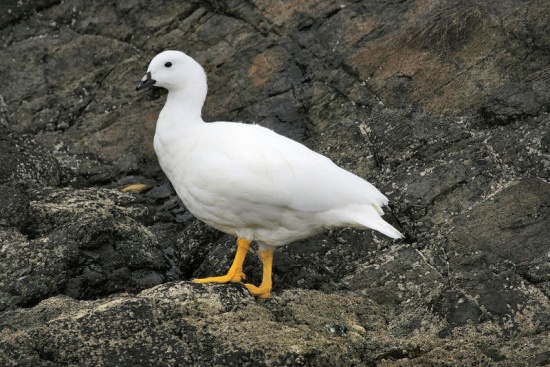- Chloephaga hybrida
Identification
There is substantial sexual dimorphism in this species, and is a rare case in which the female is much more dramatically marked than the male.
Male: Almost pure white with a few scattered darker feathers. Black bill and yellow feet.
Female: Dark with white barred underparts; only the rear of the bird is white. Pink bill, yellow feet. Wings have black primaries and green greater coverts.
Immature male: Similar to adult male but with tertials blackish[2].
Juvenile:Similar to adult female but lacks green iridescence in greater coverts.
Similar species
Yellow legs separate the male from the most similar Sheld-Geese. Female is superficially similar to Upland Goose but blacker head and upperside in greater contrast to white vent should make even distant observations obvious.
Distribution
Coast in southern half of Chile, southern Argentina, Tierra del Fuego, and the Falkland Islands.
Taxonomy
Two subspecies are recognized:[1]
- C. h. hybrida: Smaller.
- C. h. malvinarum:
Habitat
Rocky coasts.
Behaviour
Usually found in pairs.
Breeding
The 2-7 eggs hidden in long grass.
Diet
Their diet consists mostly of kelp, for which they migrate along the coast of South America. They also take filamentous algae (Enteromorpha), sea lettuce (Ulva) and leafy algae (Porphyra), found on tidal rocks. They also feed on green grasses on their breeding grounds and berries during winter. [3]
References
- Clements, J. F., T. S. Schulenberg, M. J. Iliff, D. Roberson, T. A. Fredericks, B. L. Sullivan, and C. L. Wood. 2017. The eBird/Clements checklist of birds of the world: v2017, with updates to August 2017. Downloaded from http://www.birds.cornell.edu/clementschecklist/download/
- Birdforum member, personal observations
- Del Hoyo, J, A Elliot, and J Sargatal, eds. 1992. Handbook of the Birds of the World. Volume 1: Ostrich to Ducks. Barcelona: Lynx Edicions. ISBN 978-8487334108
- Jaramillo, A. 2003. Birds of Chile. Princeton & Oxford: Princeton Univ. Press. ISBN 978-0691117409
- Wikipedia
Recommended Citation
- BirdForum Opus contributors. (2025) Kelp Goose. In: BirdForum, the forum for wild birds and birding. Retrieved 25 April 2025 from https://www.birdforum.net/opus/Kelp_Goose
External Links
GSearch checked for 2020 platform.1






